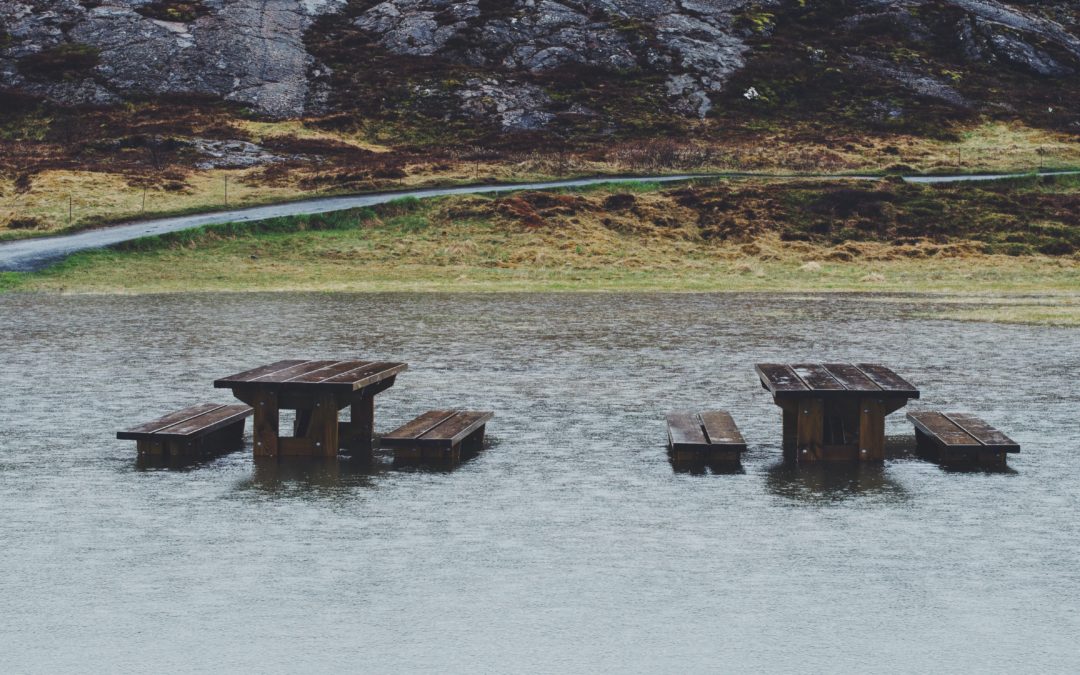The following is a contributed piece by guest writer, Jennifer Taekman.
With Earth Day approaching, and as we continue to face a global pandemic of epic proportions, there are many scary things we humans are working through. The climate crisis remains a concern for our species to address, and the effects come in many forms. Despite carbon emissions being temporarily lowered, once the mandate is lifted, we will return to the streets. Our hope is that there will be a new approach to the way we do business – and that we address some of the pressing effects of a rapidly changing climate, such as sea level rise.
Whether you live close to the ocean or in a land-locked location, if you haven’t yet experienced flooding, you likely will. The changes caused by climate change have led to various types of flooding, including coastal and urban flooding, which are challenges we must overcome. Let’s look at what the different types of flooding, how they affect communities, and then dive into two solutions inspired by nature that can help address these concerns.
What’s the deal with flooding?
Coastal flooding occurs in conjunction with sea level rise. Winds from hurricanes or coastal storms push a large wall of ocean water onto land, which is capable of causing incredible devastation not only to ecosystems, but to infrastructure as well. Almost nine million Americans are vulnerable to this type of flooding because of living in coastal areas.
Similar to coastal flooding, urban flooding is also caused by storms. However, urban flooding is a drainage problem and results “when rainfall … overwhelms the local stormwater drainage capacity of a densely populated area … [because] rainfall runoff is channeled from roads, parking lots, buildings, and other impervious surfaces to storm drains and sewers that cannot handle the volume.”
Nuisance, or sunny-day flooding, results from sea level rise in conjunction with high tide, but without the storms that create coastal and urban flooding. This is where water flows over sea barriers, backs up sewers, and comes up through groundwater pathways, overwhelming infrastructure capabilities. It seems inconsistent to have flooding when there’s not a cloud in the sky, but that scenario is happening more frequently in coastal locations.
What can we do about it?
Mimicking strategies found in nature, i.e. biomimicry, is increasingly being used to solve human design problems. Two projects, Bryosoil and B.L.O.T.S., with the support of the Biomimicry Institute’s Launchpad program, are developing products to help with both urban and sunny-day flooding.
To manage the risks from urban flooding (as well as to fight urban heat island effect) the creators of the Bryosoil Water Management System (Bryosoil) used biomimicry thinking to develop a multi-functional soil system. The design uses three geometric cellular patterns found in a family of lichen/moss organisms called bryophytes. They utilize osmosis and diffusion to transport water and nutrients rather than a series of “pipes” used by vascular plants (and current human water management infrastructure).
Bryosoil can alter water flow by the grouping geometry and direction of bryophyte-like cellular structures that mimic the Sphandae, Thuidium, and Campylopus mosses. These are the kinds of patterns that can heavily influence design and reveal a lot of new ways to create efficiency by replicating strategies that have proven to work in nature.
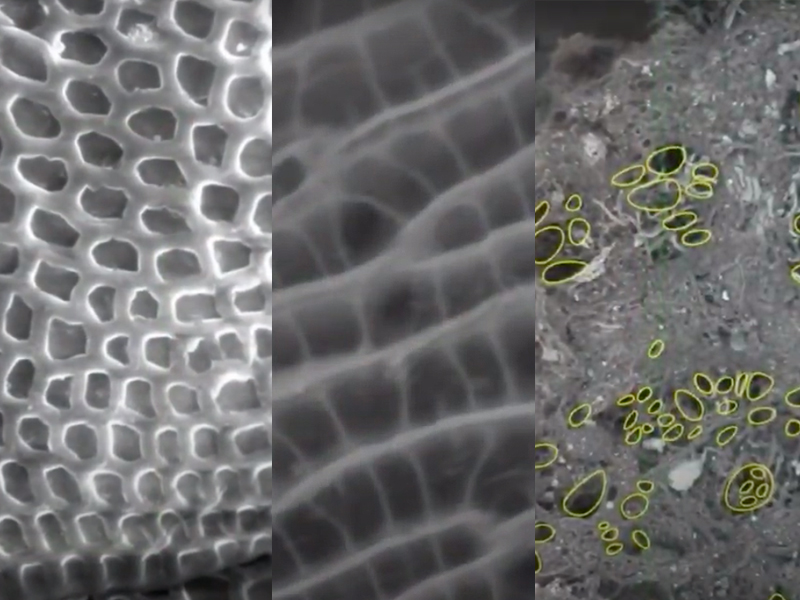
Microscopic images of bryophytes: Sphandae moss, Thuidium moss, and Campylopus moss. Images courtesy of Bryosoil.
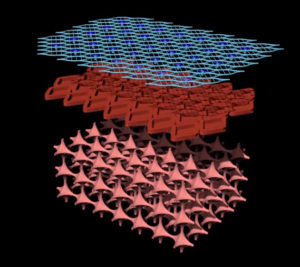
The Bryosoil design was inspired by the above three bryophytes. Images courtesy of Bryosoil.
Not only can this design transport water in one direction – it can also decrease flow rate, redirect water flow, infiltrate, store and evaporate water, all effective solutions for urban flood control.
Bryosoil can be formed into Bryomodules. When utilized below ground, these modules can catch and separate runoff water for infiltration purposes and/or to reuse it. When utilized above ground, they can be filled with permeable materials to create different types of outdoor furniture that evaporate water and cool down cities (to combat the heat island effect). Bryosoil can also be formed into Bryotiles, which, when used on top of the ground, can be configured to slow down, conduct or redirect water away from communities and infrastructure at risk. Byrosoil kits are easy to transport and assemble and can be arranged for different flood scenarios.
B.L.O.T.S., short for the Biomimetic Land Ocean Treatment System, is a different system under development by the Biomimicry Design Alliance. Using biomimetic design thinking, this team created a system to address sunny-day flooding. To conceptualize B.L.O.T.S., they looked to Miami, Florida as an example.
Florida was at or near sea level even prior to climate change. One of the things of particular concern in Miami, and other similarly situated locations, is that sunny-day flooding regularly jeopardizes infrastructure. “Once the infrastructure becomes compromised due to flooding, people lose access to utilities, food, communications and even emergency transportation.”
To address this problem, B.L.O.T.S. was designed using some of nature’s experts in attracting, absorbing, directing, and transporting liquids. Mangrove Root, the Lungfish, and Lymph vessels inspired a system designed to relocate sunny-day floodwater away from infrastructure. B.L.O.T.S. is a modular, customizable, flexible, tube-like system that can be rolled up (similar to tape) and transported easily. Its outer layers have the ability to attract, absorb and transport water while preventing debris from entry. Interior passive valves provide a unidirectional flow. Customizable spigots control when and where the water is released. Filters and storage vessels can be applied to create and store potable water resulting from the floodwater collection of the system.
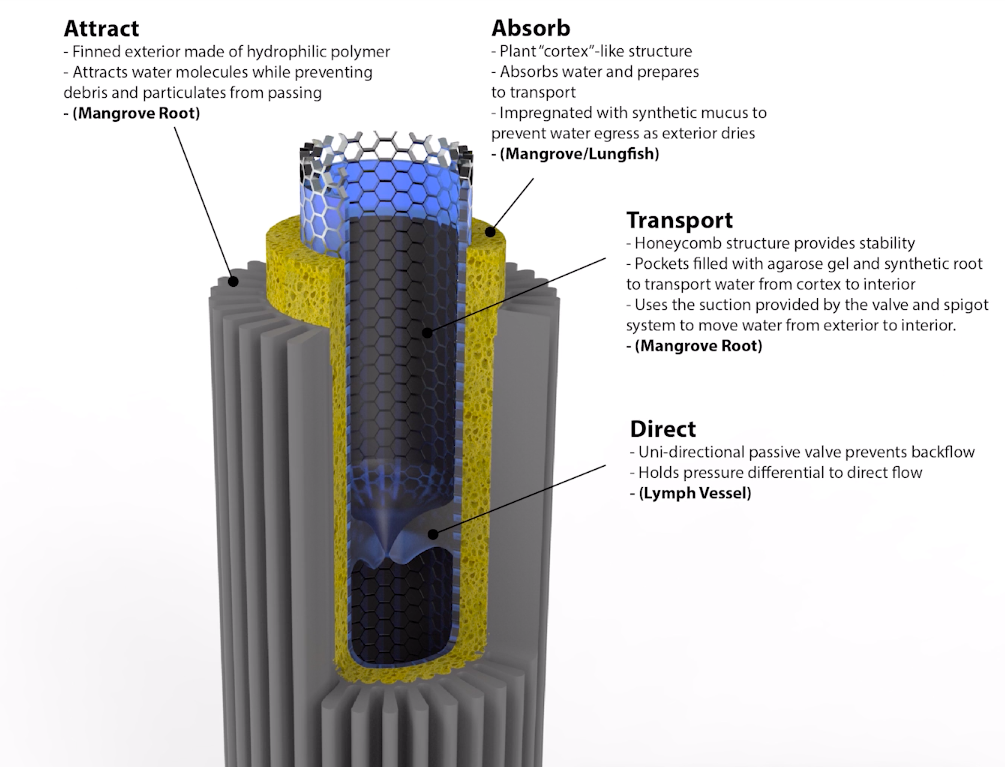
Image courtesy of the Biomimicry Design Alliance. Rendering by Clayten Skousen.
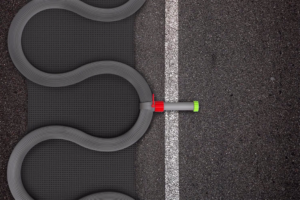
Image courtesy of the Biomimicry Design Alliance. Renderings by Clayten Skousen.
B.L.O.T.S. also provides a community with some control where it might have felt helpless before. Each component is embedded with GPS and with the accompanying smart phone application, residents are alerted to flooded areas. Through this technology, people are also informed as to where B.L.O.T.S. is required, allowing for self-organization and mobilization to set up the system.
As the above biomimetic designs illustrate, humans are incredibly innovative and creative problem solvers. It is both practical and hopeful that we continue to tap into nature’s billions of years of innovation to find solutions to issues facing us today and in the future.
Disclaimer: The views and opinions expressed in this article are those of the authors and do not necessarily reflect the official policy or position of the Biomimicry Institute.
 Jennifer Taekman is a Humanities-Trained-Science-Enthusiast specializing in biomimicry. She retired from practicing law to raise her two kids, who have inspired her to be a good steward of our earth, an aspiring writer, and an environmental educator.
Jennifer Taekman is a Humanities-Trained-Science-Enthusiast specializing in biomimicry. She retired from practicing law to raise her two kids, who have inspired her to be a good steward of our earth, an aspiring writer, and an environmental educator.
Twitter: @JenniferTaekman; FaceBook: Jennifer Taekman

